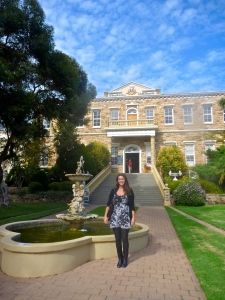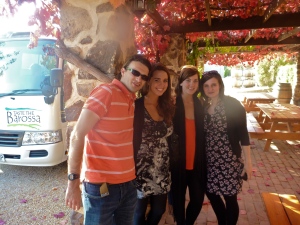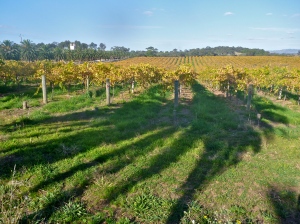At this point, I think I would be content just touring the wine regions of Australia. There are so many different regions, and they all produce such excellent wines! Barossa Valley was no exception. South Australia is one of the driest states in Australia. The Murray River hasn’t been flowing the last 4 or 5 years, but this year has seen a considerable amount of rain (especially with all the flooding in Queensland, Victoria, and northern New South Wales). The Murray River is now at 70% capacity with numerous lakes and such. The rainfall that came this past summer was great for the region, but it also took its tolls. Many of the grapes in the Barossa Valley and surrounding wine regions were overly moist and actually molded. Some of the wineries embraced this and used those grapes for sweeter blends. But it also gave the wineries fewer grapes to make their usual wines with this year’s vintage. They were still able to produce good quality wines, just a much smaller amount of them.
The Barossa Valley is a very versatile area, most comparable to the Mediterranean climate. Whereas Margaret River produced fairly consistent conditions throughout the region and all the different vineyards, Barossa Valley is home to both ranges and valleys. Our guide said he’s witnessed wine tastings in which the tasters could actually pinpoint where the grapes came from within 100m… I’m not totally convinced that’s possible, but it certainly sounds cool! With over 800 grape-growing families in the region, the Barossa is mainly known for its Shiraz and big red blends (similar to McLaren Vale and Coonawatta), but then it also was awarded with the best Riesling in the world at the last wine show. The vineyards in the ranges are much more similar to those in Adelaide Hills, which is cooler and produce better white wines. The Barossa’s fame stems from what it has been able to achieve in such a small area.
The Whispering Wall
Our first stop on the Taste of Barossa wine tour was The Whispering Wall in Adelaide Hills. The dam was constructed in 1903, and upon completion they discovered the wall had perfect acoustic qualities. Our guide stayed on one side of the wall, and the rest of us went and stood on the other. Even though we were standing 140meters apart, you could literally whisper and it would travel to the other side with the same (if not louder) volume. There was even an Asian tour group that was boarding a bus in the parking lot, and we could hear them chatting from all the way on our side! Very cool spot… not to mention great views!
Yaldara Estate
Once we got into the Barossa Valley, we made our way to the first wine tasting of the day at the McGuigan Winery at the beautiful Chateau Yaldara.
Our first tasting was a Sauvignon Blanc, which I didn’t like. But then they redeemed themselves with a French oaked Chardonnay, which had a rich, buttery smell and tasted like vanilla and maybe even eggnog. Then we sampled a Miscardo (my first ever), which was sweet and light and had a clean finish. Pretty forgettable by the end of the day though. For the reds, we sampled the GSM and then the 100% Barossa Valley Shiraz, which was very peppery with large tannons. I’m still learning to appreciate the reds, but everyone else seemed content with its quality. After the whites and reds, we got to the interesting stuff. We tried a “fortified” VP wine (VP, short for vintage port because it technically can’t be labeled as a port in the Barossa), which is essentially a more concentrated wine with brandy in it. The VP was pretty sweet but full of flavour. Then we tried the tawny, which was straight up brown in color and smells very strongly of alcohol. Kinda intimidating for our first tasting session of the morning! Tawnies stop aging once bottled, but they allow for a longer window of drinkability. They keep in the bottle for up to 20 years, and are still a good drink for 5-6 months after opening the bottle.
Tanunda
This stop was probably just a way to drag out the day, but it was interesting because this little historical town revealed a good amount of Barossa Valley history. The region was first settled in the 1840s by British colonials and German Lutherans – the 1st non-convict settlement! Just walking down the tiny strip of main road, we saw some beautiful Lutheran churches and other relics of its history.
***Peter Lehmann Wines***
This winery was my absolute favorite location of the day, not only for its excellent wines, but also for its romantic story of winemaking. In the late 1970’s, the Barossa was apparently yielding too many grapes, so the government offered to pay vineyards for the vines they uprooted. Peter Lehmann knew that the best grapes came from the oldest vines, so in 1979 he went out on a limb and contacted vineyards himself and offered to buy their grapes so that they wouldn’t uproot their century old vines. He held a strong passion for wine and even moreso for the potential of the Barossa Valley that he didn’t want to see crumble. In doing so, he essentially saved what is now Australia’s most influential and internationally recognised wine region. Because of his “Mentor” status in the region, Peter Lehmann has good relationships with over 150 winemakers as well as access to grapes from over 900 vineyards. Peter’s son, Doug, has now taken over Peter Lehmann Wines, but the woman hosting our tasting rolled her eyes and laughed when she said Peter still shows up quite often and can’t seem to give it up. It seemed like such a fun and inspiring environment to be a part of. You have to admire that man’s passion for wine and the Barossa!
We sampled eight different wines, but I’ll spare you from having to read my reviews on each of those. But there are two wines definitely worth telling about! The very first wine we tasted was the 2010 Eden Valley Dry Riesling. Riesling was first planted in the Eden Valley in the early 1850’s. This area is located high in the Barossa ranges and is home to shallow, rocky soils, which later proved to be a natural home for Riesling – which Peter calls the “noblest white wine variety.” I’m usually not a fan of Rieslings because they are too sweet, but this one was drier than usual (hence its name), and actually became my favorite wine we sampled here. Certainly one to track down for later enjoyment!
The other more memorable wine of the day was the 2006 Black Queen Sparkling Shiraz. The sparkling Shiraz is a unique Australian wine style, first developed in South Australia in the early 1800’s. Peter Lehmann Wines started making a few cases each year in the 1980’s purely for the indulgence of the winemakers. They released their first sparkling Shiraz to the public in 1999 from their 1994 vintage, The Black Queen being a gambler’s card, but of course it was a hit. We heard more than enough about this sparkling Shiraz of the Barossa throughout our entire tour, so it was a climactic moment when we actually got to try some ourselves. It was amazingly refreshing with the perfect amount of zing. I can’t believe it hasn’t caught on in other regions!
After our wine tasting, we went to an adjacent room for a family-style lunch. We each bought or split wines from the Winery and picked at platters of various meats, cheeses and breads from the Barossa Valley. I sat with a young group from the UK that had met on a previous tour to Adelaide. English Andy and I shared a bottle of the 2008 Barossa Shiraz. It was comforting to know I was able to mingle and make friends on such a short tour. I’m really looking forward to the more lengthy ones now!
Langmeil Winery
We were given the choice at lunch to either sit and drink finish off our bottles of wine or meander down the pathway to the Langmiel Winery. The UK clan and I took our sweet time talking and then realised we didn’t have much time left, so we screwed the cap back on our wines and wandered over to the Langmiel: home of the oldest known Shiraz vineyard in the world.
This tasting was less structured, so we were only served upon request. We sampled the Sparkling Ondenc Cuvee, Chardonnay, and Riesling… none of which I much cared for. Then we tried the Bella Rouge, which is a darker Rose made with Cabernet Sauvignon. Very good! Now running out of time, we decided to throw out some big guns and request the most expensive wines on the list. The Valley Floor Shiraz was dry with a medium/full body – typical of the Barossa Valley. I preferred the “Freedom” Shiraz, which is usually not available for tasting. This may be because I’m feeling especially patriotic after learning of Osama Bin Laden’s death, but then again it was a pretty remarkable wine. These Shiraz vines were family-planted in the mid 1840’s, are hand picked and pruned, and are dry grown – meaning they rely solely on natural rainwater rather than irrigation. The more water given to vines, the more fruit they produce; but the more fruit they produce, the lesser the quality of the grapes. Therefore these dry vines are very unusual and only used for the oldest vines, which produce the best quality fruit. The reason the Barossa is home to some of the oldest Shiraz vines in the world is due partly to Peter Lehmann’s initiative in preserving them, as well as the fact that the Barossa has never had any problems with phylloxera, a disease that can ruin the vines to the extent that they must be uprooted. This blessing is the result of both hard work and a little luck.
Seppeltsfield
The original Mr. Seppelt started this vineyard in 1851 proclaiming that it would not produce a single vintage until the vines reached the age of 100 years. Adhering to his wishes, Mr. Seppelt’s family released the first vintage in the 1970’s. These wines now go for as high as $1,500 per bottle, and you better be certain that they sell out as well. I guess his plan was successful, even if it was only his descendants who benefited from the cause. We didn’t actually have any tasting in this vineyard (shocking, hey?), but we managed to capture some amazing pictures of it.
Murray Street Vineyards
Andrew Seppelt is a 6th generation winemaker, who opened this small winery himself after working in the famous wine regions of France and the United States. So even though we didn’t get to try any Seppeltsfield wines, we were able to experience this fusion of the old and new that Andrew brought to the region. Our wine tasting took place on the outdoor patio of the winery, overlooking the beautiful vineyard.
My favorite wine from this location was the 2006 Sophia signature Shiraz, which our host, Jason, claimed is “exactly how Shiraz should be,” which is just fine by me. Although I particularly liked how he described his affection for the 2006 Benno: “I’ll stick it on cornflakes.”
Post Wine Tour
When we were dropped back off at our accommodations, the driver was a little awkward when he realized he had accidentally given the rest of my and Andy’s Shiraz to another couple who left before us. I probably should have been a little more annoyed, but it actually got me off the hook for making dinner plans with the UK group. Instead my local Adelaide friend, Christian, gave me a speed tour of Adelaide including Glenelg Beach (where we had dinner), the cricket stadium (which they are expanding by 20,000 seats to accomodate the Australian Football League games), and some Gothic-style churches among other things. Early to bed and early to rise! My pickup for Kangaroo Island is at 6:20am tomorrow…








Nevermind the last email. Thanks for updating! This is awesome, I can’t believe you are doing this. I look forward to trying out a few of these wines you talked about. Hopefully, we can find them here in Nashville!